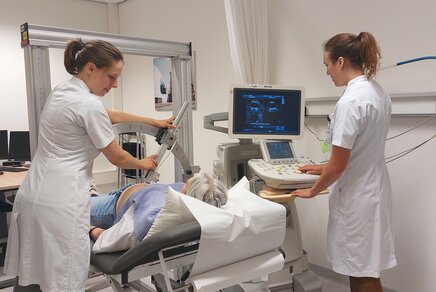Brainpower in comic book form
Instead of handing out a hefty thesis, Elles Raaijmakers drew an accessible comic book about her research on electric current and brain cells.
![[Translate to English:] [Translate to English:]](https://assets.w3.tue.nl/w/fileadmin/_processed_/f/e/csm_BvOF%20Elles%20Raaijmakers_9b90a09c24.jpg)
What's not to like, an inspiring lecture given by an enthusiastic professor. An upbeat message and decades of research distilled into a single slide. But PhD candidate Elles Raaijmakers is keen to show the other side of the story: failed experiments, countless setbacks and years of hard work. While working as a member of the Education Team, she carried out doctoral research on the influence of electrical fields on brain cells. Instead of handing out a hefty thesis – although she has written one – she drew an accessible guide to her research experiences in the form of a comic book. On Thursday, June 8, she defended her research at the Department of Electrical Engineering.
Perched on the edge of her seat, Elles Raaijmakers is enthusing about Santiago Ramón y Cajal – “perhaps the most wonderful story in the history of neurobiology” – an outsider who went on to become ‘the father of neuroscience’. To find out exactly why Raaijmakers was researching electrical currents and brain cells, she delved into the history of brain research. She found herself reading numerous familiar stories. She was particularly buoyed to learn that even for the big names in the field success didn't come automatically.
“It can sometimes seem as if they had a flash of inspiration, did some experiments and immediately came up with an innovative theory. But nothing could be further from the truth. I found evidence of long roads traveled, with struggles along the way. Such was the experience of Andrew Huxley and Alan Hodgkin, who ultimately received the Nobel Prize in Physiology or Medicine for their model describing the action potential. Their journey started with years of trial and error, making discoveries they couldn't explain, working alongside colleagues in the field who didn't understand their out-of-the-box thinking. Still, despite all this, they persevered and finally their efforts paid off. And that gave me hope. There's no rule that says that if you're struggling you have to throw in the towel. I like to give students this message instead of skirting the issue.”
Control
Raaijmakers is speaking from experience: the road to her doctorate was a bumpy one, to put it mildly. “Usually, as a recent graduate, you throw yourself wholeheartedly into your project, anything seems possible. Gradually, however, you realize that plucking what your supervisor calls ‘low-hanging fruit’ isn't the simple matter it's made out to be. And the focus on success and achievement is extraordinarily sharp. You're dependent on people around you, and might even find yourself swept along in a direction that, once you stop and look, you realize isn't where you want to go at all. I felt I had lost control of my research. A new team of supervisors gave me the chance to get back in the driving seat, and so now I can honestly say this is my thesis.”
Coping mechanism
To cope with her struggles, Raaijmakers found it helpful to draw cartoons. She has been an avid user of pencil and paper since her high school years; for years she produced a weekly cartoon strip for Cursor. During the long train journeys – she carried out some of her experiments at the University of Amsterdam; her project was a collaboration between the two universities – she drew in order to vent both her frustration and her inspiration. But increasingly she found her doodles were helping her to answer a question: why I am doing these experiments ?
“The chance to join the Education Team arose fairly early on in my doctorate studies. I seized the opportunity: I'm really excited by the combination of research and education. For a number of years I was a teaching assistant – that brings home the importance of conveying knowledge effectively like nothing else does. I noticed that often too little attention is paid to the ‘why’ of research, yet this can be what helps people connect with it. To use the words of Ionica Smeets (professor of Science Communication and Society at Leiden University and well known for her popular-science columns, ed.), of whom I am a big fan: science communication is still too often a monologue, we need to be conversing more with one another.”

Comic book
Raaijmakers decided to present her traditional public summary in the form of a comic strip, and to give it to her audience as a separate booklet. By offering a glimpse into the history of neuroscience – including the inevitable failures – she hopes to clarify the context of her own modest contribution. What exactly happens in a single brain cell when the brain is stimulated? The Romans, we learn from her comic book, were already using this technique: an electric ray would be placed against the head of a patient with a severe headache. The electric shocks administered by the fish were believed to ease the pain. “There are many myths related to brain stimulation and, yes, you'll also come across Frankenstein in my story,” says Raaijmakers, laughing.
Nudge
But what actually happens to a neuron when it is exposed to an electric field was revealed to her thanks to an ingenious technique. In hippocampal neurons, whose long protrusions make them well suited to taking measurements, Raaijmakers saw that a weak electric field could generate new mini currents. With the aid of a special fluorescent dye, it was possible to measure calcium release, which sets in motion all kinds of learning and growth processes. “In essence, we were giving neurons a nudge in the right direction, toward their tipping point, and this enabled me to show that even a minimal electric field can have an effect.”
She hopes one day to be able to work at the interface between neurons, chips and engineering, to be lending her brainpower to the development of innovative brain-on-chip technology and neuromorphic devices. But for now she can be justifiably proud of her first ‘scientific baby’, including a special booklet for the general public. “In that sense Cajal has been a good source of inspiration. He was always working on visuals and, in fact, wanted to head in an entirely different direction than medicine. But then along came the microscope and he was the only person who could create detailed drawings from microscope images. Ultimately, he found a way to remain true to himself in a competitive field. Being an outsider can have its advantages.”
Source: Cursor
Media contact
More on Health



Latest news


![[Translate to English:] [Translate to English:]](https://assets.w3.tue.nl/w/fileadmin/_processed_/e/0/csm_BvOF%202019_1031_BHF%20license%20TUe%20ILI%20copy_8a50884392.jpg)